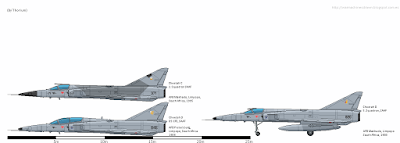As we said earlier, the Cheetah was, basically, a vast development of the Dassault Mirage III, and the first of those airplanes to be converted was the Mirage IIIDZ no.845 which was bought by Atlas Aircraft Company in April 1983 and the modifications were finished on 16th July 1986, by the time that various Cheetah Ds were in active service with the South African 89. Combat Flying School based at AFB Pietersburg but it wasn't only until 1987 that the type was declared operational.
Later, the company bought some Mirage IIIEZ in order to convert them into Cheetah Es and entered service with the South African Air Force at AFB Louis Trichardt serving with the 5.Squadron. More precisely, 16 of each type were in service by 1991 when the production lines for the Cheetah E and D closed, by which time the Cheetah C were being converted and the first of them rolled out of the production lines on January 1993.
Every Cheetah C entered service with the 2. Squadron SAAF, which was also based at AFB Louis Trichardt.
None of the Cheetahs saw combat action in the Border war, so their performance was never tested against the MiG-23 and the Cheetah Es were used as interceptors with a minimum of two of them staying in permanent alert status until the Border War ended in 1989.
When the more modern Cheetah C entered into service, the Cheetah Es were withdrawn from the active service and the 5. Squadron SAAF was disbanded in 1992. Soon after, the 89. Combat Flying School was also disbanded and the Cheetah Ds were transferred to 2. Squadron SAAF, where they remained in active service until 2008.
However, two Cheetah Ds are still operated by Denel Aviation at the Overberg Test Flight and development center.
The variants of the Cheetah are:
- Cheetah D: The sole two-seater variant which was used mainly for training duties. It had also secondary attack capabilities as it could deliver some PGM. Some of them received an upgraded version of the Atar 9K50C-11 engine plus some upgrades in avionics systems.
- Cheetah E: A variant developed as an interim fighter until the Cheetah C were available, as it was thought as an interceptor, it was armed mostly with air-to-air weaponry, mainly V3B and V3C missiles.
- Cheetah C: The final development of the Cheetah, was the only fighter type serving with the South African Air Force until being replaced by the SAAB JAS39 Gripen in 2008. It was equipped with an improved pulse-doppler multi-mode radar (ELTA) and had also improved helmet and HUD systems. It featured also an anti-radiation shield wraped around the windshield a revised in-flight probe, an upgraded version of the Atar 9K50 engine and a new nose to fit the new radar. As the previous versions it could deliver precision-guided munitions, GPS-guided bombs and TV guided bombs plus various air-to-ground weapons and air-to-air missiles.
Sources:
1. https://en.wikipedia.org/wiki/Atlas_Cheetah
2. Salamander Books - The Complete Book of Fighters


No comments:
Post a Comment